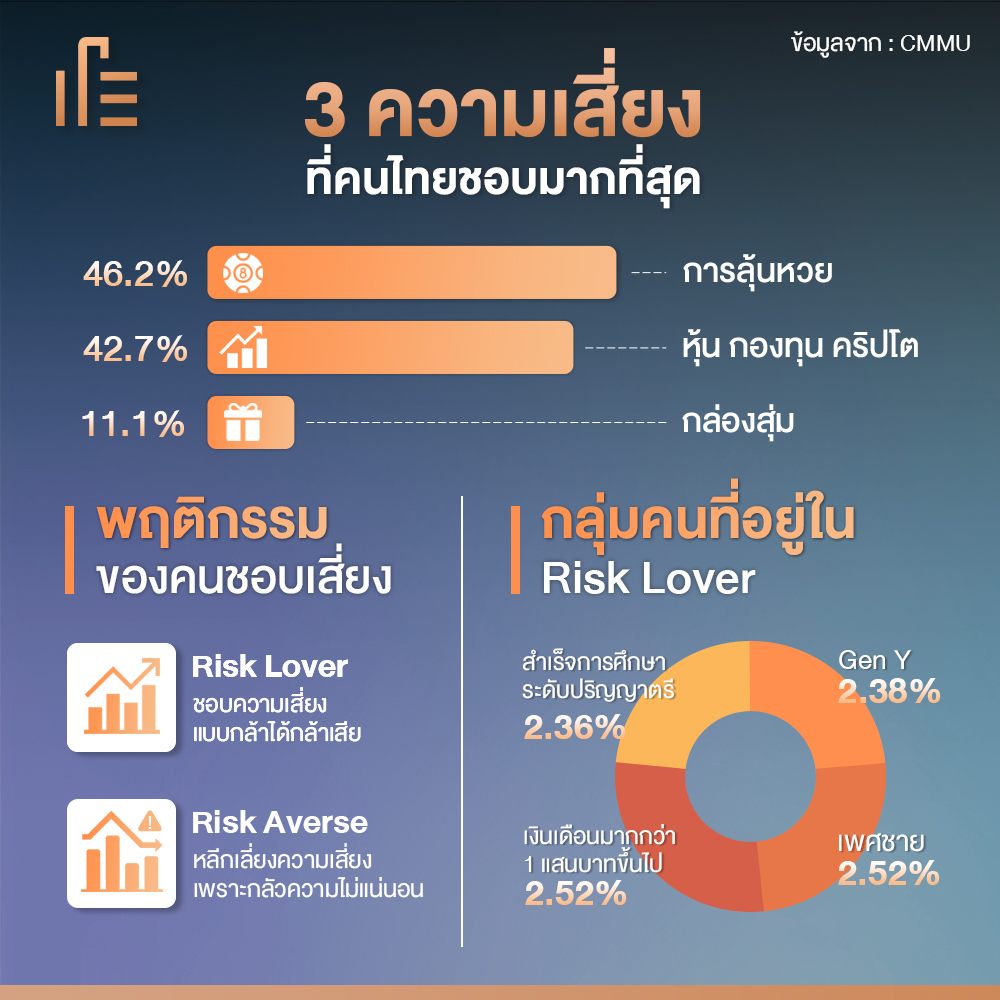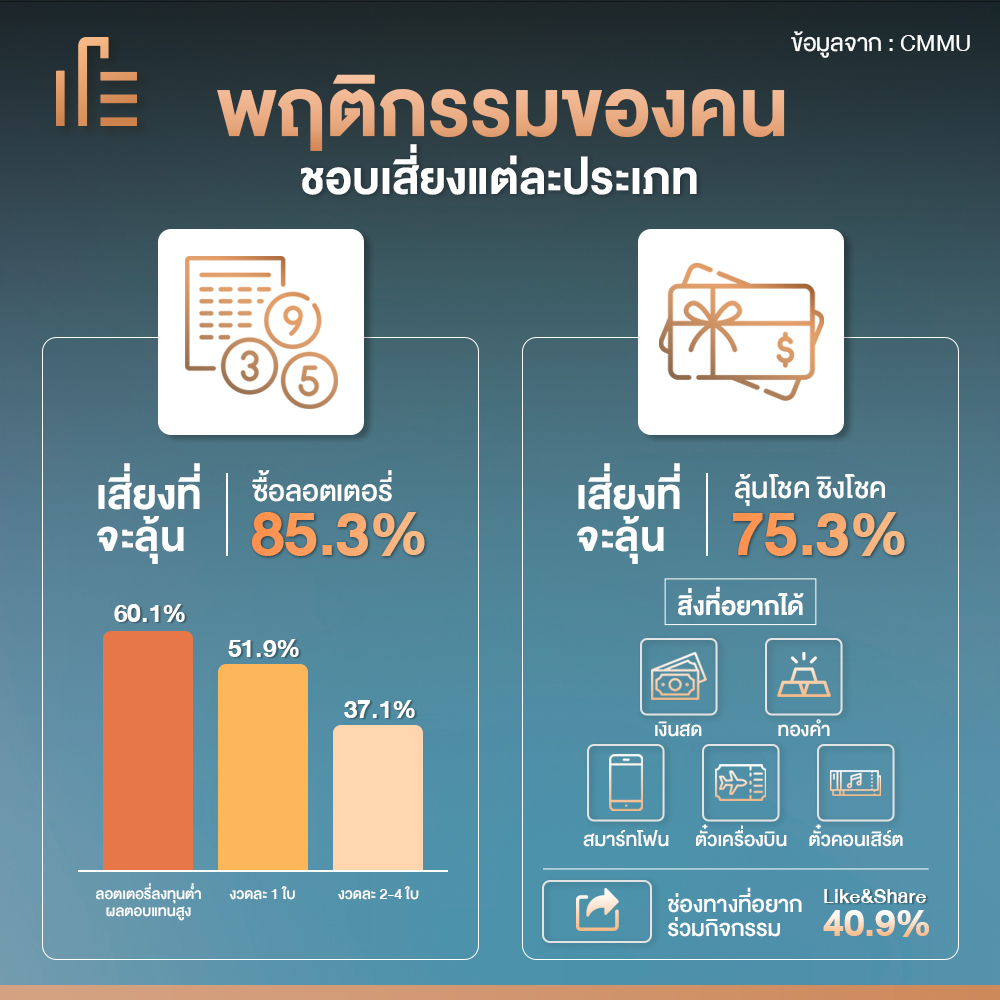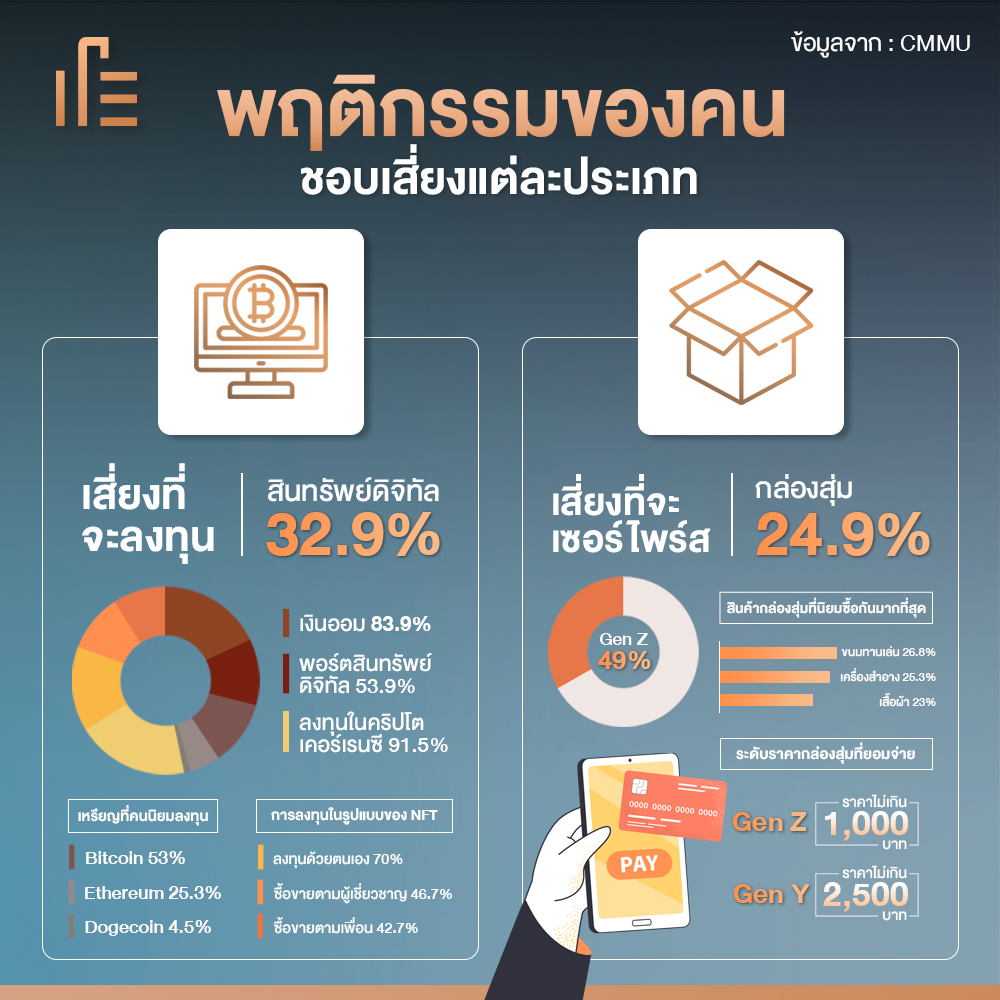college of management Mahidol University or CMMU (CMMU) reveals research data. “Decoding the idea of conquering the minds of risk-takers, Marketing to Risk lover” found that the top 3 Thai people who like to risk the most
risk to win Compared to the population of 30 million people. risk to invest and risk surprise The Gen Y and male groups are Risk Lover like to take risks the most enterprising along with introducing new strategies in line with current consumer behavior for entrepreneurs or marketers Chef’s Table restaurant operators and investors or investment companies Create opportunities for better business and continue to survive.

The trend of eating behavior of consumers today and investors or investment firms who want to know their current investment attitudes and investment choices. By surveying a sample of 1,000 people and conducting in-depth interviews with 40 people, the sample was divided into 71.5% female (number 716 people), 23.6% male (number 236 people), LGBT+ 5% (number 50) and divided by generation. The levels are as follows: Gen Y 54.6% (547 people), Gen Z 24.8% (248 people), Gen X 12% (120 people), and Baby Boomer 8.7% (87 people).
by research resultsRisk behaviors of Thai peoplewith the question of whether Do Thai people really like to take risks or not? analyze that Because Thai society believes in superstitions. relying on the sacred This was due to the uncertainty of the economic downturn. The cost of living is rising while income is falling. There is also an epidemic situation. Make people turn to these things as a driving force and motivation. The belief factor is one of the important factors influencing consumer behavior. Because beliefs determine intentions and behaviors. Therefore, the superstition, like to gamble and win luck, is what consumers use to deal with the uncertainty they are facing, and it encourages consumers to relieve their concerns about the uncertainty that arises.
While the top 3 Thai people who like to risk the most from a survey of the sample group, it was found that 1. Risk of winning 46.2% if compared to the population as high as 30 million people, such as winning lottery tickets, winning big prizes from sweepstakes, for example. Oishi doing the activity to send numbers under the lid. or drinking water Luck activity under the lid Fill in to get points to win big prizes
It was found that 75.3 percent of the sample participated only when the grand prize was attracted. Indicates that the activity has attracting factors as well. 2. Risk to invest 42.7%, compared to the population of about 28 million people, such as stocks, funds, gold, and the upcoming cryptocurrencies.
Many private and government companies have begun to accept the use of cryptocurrencies. For example, Japan has announced that bitcoin can be used to pay for goods and services in the country. Legitimate and most recently El Salvador is pushing the law to support bitcoin in the country and 3. The risk of surprise 11.1% compared to the population of about 7 million people, such as buying a random box. Chef’s Table Dining or Private Dining In which there will be chefs to create various menus according to the chef’s wishes, which are special in both raw materials and stories. It’s called the art of eating a form of food. where customers do not have to open the menu, choose their own food and see what menu they will eat and how special the experience is

From the above 3 types of risks, when analyzed will find that those who are the target of various risks It will take the substance and convert it into a behavioral response. Can be divided into 2 types of risk lovers: Risk Lover enterprising Accepts the volatility and uncertainty that may arise and the Risk Averse type. risk-averse Do not gamble for fear of losing money. Need for certainty for yourself is quite high. And when examining in depth, we will find 3 human instincts that indicate desire. “Risk for a better return” consists of 1. People who want to gamble, 2. People who like to have fun, and 3. People who want to wake up and become rich. with the hope that the risk that the investment is taking risks will result in a response that will change lives from front to back
from asking the question “Do Thai people really like to take risks?” and “How much are they a Risk Lover?” So a psychological test was made from choosing cards. which is a risk reflector Divide the cards into 5 piles, each pile has 2 pairs of cards as follows: The first pile is a non-risk midfield consisting of 5,000 baht each. The second pile slightly increases the risk. Consists of 6,000 baht each and 4,000 baht each. The third pile increases the risk and wins a big prize with 7,500 baht each and 2,500 baht each. The fourth pile has 8,000 baht and 2,000 baht each and the fifth go hard or card. Go home, risk it as much as possible. There are 10,000 baht each and the one that doesn’t get anything.
From the survey, it was found that The pair of cards that people choose the most are 34.5% in the first pile, which is 5,000 baht, whichever card they choose, followed by 29.7%. The second pile is a bit more risky, but not very risky, followed by 18.3. % third pile, 10.6% fifth pile and 7.3% fourth pile, respectively, and if looking at the meaning of the selection of cards divided by sample divided by generation, gender, salary, social status And the study concluded that those who are classified as Risk Lovers have the most is Gen Y, up to 2.38%, the most males from other genders, up to 2.52%, those with a base salary of more than 100,000 baht or more. the most with 2.85%, the most separated 2.75%, and 2.36% of graduates with a bachelor’s degree or higher.
When analyzing the insights of 3 types of risks, namely, risk to win. risk to invest and risk surprise find in-depth information Behind more interesting consumer behavior ready to offer marketing strategies Sorted by topics for each risk as follows:

Start at the risk to win – the lottery side According to a survey of Thai people’s behavior, the majority of the respondents had bought lotteries as high as 85.3%, indicating that Lottery purchases are accessible to all genders, ages and income levels. Most of the sample group bought 1 lottery ticket per draw at 51.9% and bought 2-4 tickets per draw at 37.1%. Gen X and Baby Boomer adults buy 2-4 lottery tickets per draw, more than working-age people and teenagers like Gen Y and Gen Z who buy only 1 lottery ticket per draw.
Maybe it’s because generations like Gen Y and Gen Z are more interested in investing. because buying a lottery is a win use probabilities Unlike investments that have a chance to earn more returns than relying on luck, luck and behavior, 60.1% of Thai people view lottery as a low investment. but get high returns that although this period is not cheap, there is always the next installment, 63.3% have to pay respect to the monks most of which asked to win the lottery get richer by popular places to ask such as Thao Wessuwan or like Naka Cave Wat Pa Kham Chanod Mae Nak Phra Khanong Shrine and King Cobra Shrine
Take the risk to win – the lucky draw, the lucky draw from the survey results of Thai people’s behavior Most people expect big prizes from sweepstakes as high as 75.3%, indicating that Most of the people who participate in the sweepstakes whether it is sending SMS, sending codes under the drinking water cap Or even write names – addresses drop into the cabinets in various leading department stores. There is an expectation of a big reward. which most of the rewards that consumers want to receive Most of them are valuable items such as cash, gold, or specific prizes such as smartphones, plane tickets with accommodation. concert tickets, etc. by marketing the sweepstakes sweepstakes promotion It is still an effective brand promotion tool and drives sales throughout today.
Make brands known by word of mouth, advertising, motivating customers with giveaways. It also makes it possible for new customers who may switch brands to try our products easily with a sweepstakes campaign. Scorching code, etc. However, found new information in the site that Traditional marketing sweepstakes is not as flashy as before. because consumers consider It’s a waste of time to fill out your own information in order to get permission. along with the COVID-19 situation to tighten costs and unable to participate in the ‘The more you send, the more chances’
As many brands have done in the past campaigns. And most of the sample group turned their attention to the Like&Share activity on social media instead of up to 40.9% because the activity was not a complicated process. It’s easy to do anytime, anywhere, and although Page Like&Share returns are not as high-value grand prizes as sweepstakes. But getting a small return It makes consumers feel lucky and win prizes as well.

Next comes the risk of investing – digital assets. According to a survey of Thai people, it was found that 32.9% of the sample group had invested in digital assets. In addition, the majority of the sample group, up to 83.9%, used “savings” to invest in digital assets. which will use the investment per transaction at 5,000 – 20,000 baht per time. The size of the digital asset portfolio currently held by the sample group is 50,000 baht, representing 53.9%, which is less than 10% when compared to the total investment. and from the survey results, it was found that The most popular coins to invest in: 1st is Bitcoin 53%, 2nd is Ethereum 25.3%, 3rd is Dogecoin 4.5%, and so on.
And between crypto-currency investments and NFTs, 91.5% were more interested in crypto-based investments than NFT-based investments. The results in trading or investing are the top 3, which are 70% self-educated or traded by experts. (Analyst & Analyst) 46.7% and Friends Trading 42.7%. Gen Z was found to be the most interested in investing in crypto, citing wanting to get rich quick. Meanwhile, 88.8% of the sample. It is well known that this type of investment is more volatile than other types of investments.
but still decided to invest because I believe High risks often bring high rewards as well. And admitted to being most concerned about the ever-increasing news of a tax on this type of investment. followed by being able to use or take full advantage of digital assets or not
followed by a risk of surprise – random box and Chef’s Table eating style. According to a survey of Thai people’s behavior, it was found that 24.9% of the respondents had bought a random box. Snacks 26.8%, cosmetics 25.3% and clothing 23%, respectively, which are the random box prices that most of the sample group is willing to pay. It will be different for each generation. Research data shows that Gen Z, who are the majority of teenagers. 49% more likely to buy random boxes than other gens due to age of curiosity, wanting to try and growing up with smartphones various social media causing behavior to follow social trends fear of trend
They will buy a random box at a price of not more than 1,000 baht, while the Gen Y who has more purchasing power than Gen Z decides to buy a random box at a price of not more than 2,500 baht. Therefore, when making a random box, you must consider that What age is our target audience in order to make a purchase decision? Most of the motivation to buy random boxes is because they want to feel excited, like to win, like to be surprised. And there is an expectation that the product received will be of good value for money. Also, random box reviews from blogger influencers. with randomly unboxing content for each shop It has the effect of creating credibility for consumers to choose a random box as well.
While risking surprise – Chef’s Table style food that plays with the word “don’t know” to consumers, according to a survey on Thai people’s behavior It was found that the sample had used Chef’s Table at 28.4%, a figure that is not as high as the risk in other areas because Chef’s Table is a niche food group. The main reasons why most people choose to use this service are: 1. To create a memorable experience at a special meal 27.1% 2. To get a chance to see what the chef will create for you to eat, 25.3%. The sample group was willing to pay at 2,000-4,000 baht, or 58.9%, which is a reasonable price that most people would pay for a special meal. In addition, Gen Y groups are the ones who are willing to pay a chef’s table meal at a price of 6,000 baht if the restaurant tastes good. store reputation Including the story of the chef is impressive.
The most popular menu that people eat is Japanese food, which comes in first place at 55.8%, which is well known is Omakase, followed by Western food at 24.2%. However, Chef’s Table has been found to increase. Most of the samples were not honest with the original store. There is always a search for new restaurants, but there are repeat visits. If the same restaurant has changed the menu and fascinated by the skill of the chef But in the event that if you meet a restaurant that does not like Most of the sample did not comment on social media. But will definitely not return to use the service again. can be seen more To create a Chef’s Table restaurant, there must be standards in terms of price, taste, and complete chef’s story. Because this style of shop plays with the feeling of surprise of customers. If there is no difference, a selling point cannot be created.
The post I know it’s risky, but I’ll have to try it! when life is boring Lottery-stock-random box It’s what Gen Y boys want to excite their lives. appeared first on Thumbsup.



